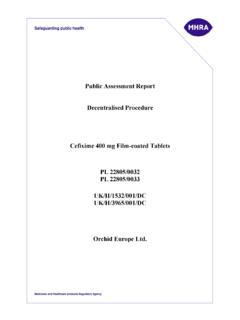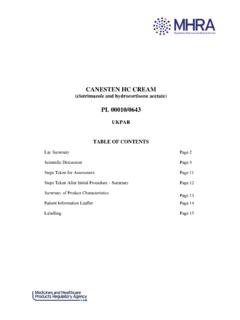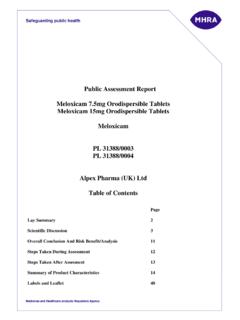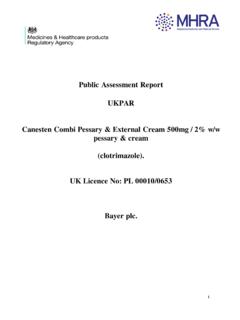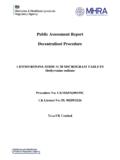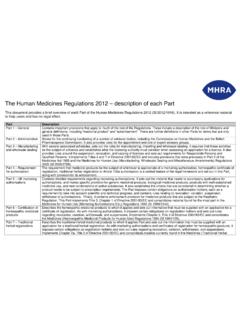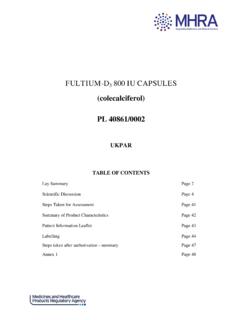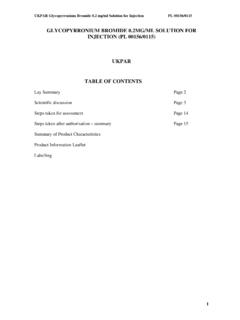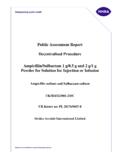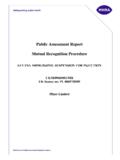Transcription of Public Assessment Report UKPAR Thiamine Hydrochloride …
1 PAR Thiamine Hydrochloride 50 mg and 100 mg tablets PL 30464/0136-0137 1 Public Assessment Report UKPAR Thiamine Hydrochloride 50 mg and 100 mg tablets ( Thiamine Hydrochloride ) UK Licence No: PL 30464/0136-0137 Athlone Pharmaceuticals Limited PAR Thiamine Hydrochloride 50 mg and 100 mg tablets PL 30464/0136-0137 2 LAY SUMMARY Thiamine Hydrochloride 50 mg and 100 mg tablets ( Thiamine Hydrochloride ) This is a summary of the Public Assessment Report (PAR) for Thiamine Hydrochloride 50 mg and 100 mg tablets (PL 30464/0136-0137). These medicinal products will be referred to as Thiamine Hydrochloride tablets in the remainder of this summary, for ease of reading. This summary explains how Thiamine Hydrochloride tablets were assessed and their authorisations recommended, as well as their conditions of use.
2 It is not intended to provide practical advice on how to use these products. For practical information about using Thiamine Hydrochloride tablets , patients should read the package leaflet or contact their doctor or pharmacist. What are Thiamine Hydrochloride tablets and what are they used for? Thiamine Hydrochloride tablets are generic medicines . This means that Thiamine Hydrochloride tablets are similar to reference medicines authorised in the UK called Benerva 50 mg and 100 mg tablets (Bayer PLC: PL 00010/0610-0611). Thiamine Hydrochloride tablets are vitamin tablets which contain Thiamine (vitamin B1). They are used to treat Thiamine deficiency (when the body does not have enough of the vitamin). How do Thiamine Hydrochloride tablets work? The active substance in Thiamine Hydrochloride tablets , Thiamine Hydrochloride , helps the body convert food into fuel (glucose), which is used to produce energy.
3 How are Thiamine Hydrochloride tablets used? Thiamine Hydrochloride tablets are taken by mouth. The whole tablet should be swallowed with water without chewing. The recommended dose in adults and children over 12 years of age is as follows: 50 mg: Mild deficiency: 1-2 tablets once a day Severe deficiency: 2 tablets 2-3 times a day 100 mg: Mild deficiency: 1 tablet once a day Severe deficiency: 1 tablet 2-3 times a day The Patient should follow the recommendation of a doctor or pharmacist. The tablets can be taken as long as symptoms persist or a dietary supplement is required. These medicinal products are not recommended in children under 12 years of age. Thiamine Hydrochloride tablets can be obtained from a pharmacy. For further information on how Thiamine Hydrochloride tablets are used, refer to the Summaries of Product Characteristics or the package leaflet available on the MHRA website.
4 PAR Thiamine Hydrochloride 50 mg and 100 mg tablets PL 30464/0136-0137 3 What benefits of Thiamine Hydrochloride tablets have been shown in studies? As Thiamine Hydrochloride tablets are generic medicines, studies in patients have been limited to tests to determine that they are bioequivalent to the reference medicines, Benerva 50 mg and 100 mg tablets . Two medicines are bioequivalent when they produce the same levels of the active substance in the body. What are the possible side effects of Thiamine Hydrochloride tablets ? Because Thiamine Hydrochloride tablets are generic medicines and are bioequivalent to the reference medicines, Benerva 50 mg and 100 mg tablets , their benefits and possible side effects are taken as being the same as those of the reference medicines. For the full list of all side effects reported with Thiamine Hydrochloride tablets , see section 4 of the package leaflet available on the MHRA website.
5 Why were Thiamine Hydrochloride tablets approved? It was concluded that, in accordance with EU requirements, Thiamine Hydrochloride tablets have been shown to have comparable quality and to be bioequivalent to Benerva 50 mg and 100 mg tablets . Therefore, the MHRA decided that, as for Benerva 50 mg and 100 mg tablets , the benefits of Thiamine Hydrochloride tablets outweigh the risks and the grant of Marketing Authorisations was recommended. What measures are being taken to ensure the safe and effective use of Thiamine Hydrochloride tablets ? A risk management plan (RMP) has been developed to ensure that Thiamine Hydrochloride tablets are used as safely as possible. Based on this plan, safety information has been included in the Summaries of Product Characteristics and the package leaflet for Thiamine Hydrochloride tablets , including the appropriate precautions to be followed by healthcare professionals and patients.
6 Known side effects are continuously monitored. Furthermore new safety signals reported by patients/healthcare professionals will be monitored or reviewed continuously as well. Other information about Thiamine Hydrochloride tablets Marketing Authorisations were granted in the UK on 15th May 2015. The full PAR for Thiamine Hydrochloride tablets follows this summary. For more information about treatment with Thiamine Hydrochloride tablets , read the package leaflet, or contact your doctor or pharmacist. This summary was last updated in July 2015. PAR Thiamine Hydrochloride 50 mg and 100 mg tablets PL 30464/0136-0137 4 TABLE OF CONTENTS I Introduction Page 5 II Quality aspects Page 6 III Non-clinical aspects Page 7 IV Clinical aspects Page 8 V User consultation Page 10 VI Overall conclusion, benefit/risk Assessment and recommendation Page 10 Table of content of the PAR update Page 23 PAR Thiamine Hydrochloride 50 mg and 100 mg tablets PL 30464/0136-0137 5 I INTRODUCTION Based on the review of the data on quality, safety and efficacy, the Medicines and Healthcare products Regulatory Agency (MHRA) granted Athlone Pharmaceuticals Limited Marketing Authorisations for the medicinal products Thiamine Hydrochloride 50 mg and 100 mg tablets (PL 30464/0136-0137).
7 These pharmacy (P) medicines are indicated for the treatment of Thiamine deficiencies due to increased dietary requirements, reduced intakes, reduced absorption or increased excretion. They are also used for the treatment of Wernicke-Korsakoff syndrome, beriberi and Thiamine deficiency related to chronic alcoholism. Situations often accompanied by marginal Thiamine deficiency and requiring supplementation include but are not limited to: Regular heavy drinking / chronic alcohol consumption High carbohydrate intakes Heavy physical exertion Compromised nutritional status High dose diuretics Type I and Type II diabetes mellitus These applications were submitted under Article 10(1) of Directive 2001/83/EC, as amended. The applicant has cross-referred to Benerva 50 mg and 100 mg tablets , which were originally authorised to Bayer PLC (PL 00010/0610-0611) on 13th August 2008.
8 Thiamine pyrophosphate (TPP), the coenzymatic form of Thiamine , is involved in two main types of metabolic reactions: decarboxylation of -ketoacids ( pyruvate, -ketoglutarate and branched-chain keto acids) and transketolation ( among hexose and pentose phosphates). Therefore, the principal physiological role of Thiamine is as a coenzyme in carbohydrate metabolism, where TPP is required for several stages in the breakdown of glucose to provide energy. No bioequivalence study was submitted and these applications are based on a Biopharmaceutics Classification System (BCS) class III biowaiver. No new or unexpected safety concerns arose during the review of information provided by the Marketing Authorisation Holder and it was, therefore, judged that the benefits of taking Thiamine Hydrochloride 50 mg and 100 mg tablets outweigh the risks and Marketing Authorisations were granted.
9 PAR Thiamine Hydrochloride 50 mg and 100 mg tablets PL 30464/0136-0137 6 II QUALITY ASPECTS Introduction These products are tablets and contain 50 mg or 100 mg of Thiamine Hydrochloride , as active ingredient. The excipients present are lactose monohydrate, microcrystalline cellulose, croscarmellose sodium, stearic acid and magnesium stearate. Appropriate justification for the inclusion of each excipient has been provided. All excipients comply with their respective European Pharmacopoeia monographs. Satisfactory Certificates of Analysis have been provided for these excipients. The only excipient used that contains material of animal or human origin is lactose monohydrate. The applicant has provided a declaration that the milk used in the production of lactose monohydrate is sourced from healthy animals under the same conditions as that for human consumption.
10 Confirmation has also been given that the magnesium stearate used in the tablets is of vegetable origin. The finished product is packed either in white opaque polyvinylchloride (PVC)/polyvinylidenechloride (PVdC)/aluminium foil blisters containing 84 tablets , or in polypropylene snap secure pots each with a high density polyethylene (HDPE)/low density polyethylene (LDPE) closure with a pack size of 100 tablets . Satisfactory specifications and Certificates of Analysis have been provided for all packaging components. Drug Substance INN: Thiamine Hydrochloride Chemical name(s): 3-[(4-Amino-2-methylpyrimidin-5-yl]-5-(2 -hydroxyl ethyl)-4-methylthiazolium chloride Hydrochloride Structural formula: Molecular formula: C12H17 ClN4OS, HCl Molecular mass: g/mol Appearance: White or almost white, crystalline powder or colourless crystals.)
